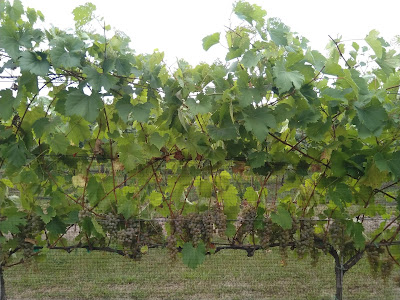Author: Annie Klodd, Extension Educator - Fruit and Vegetable Production
In this week's fruit update:
- Japanese beetle and SWD trap counts
- Grape harvest target parameters, and pests to watch for
- Apple harvest progress and what to watch for
- Fall-bearing raspberry SWD info
 |
Japanese beetle average trap counts by location, at seven farm locations in Minnesota. Source: UMN FruitEdge
|
For updated spotted wing drosophila trap counts, please visit FruitEdge.
Grapes
Many grape growers were harvesting Itasca and Brianna last week. Some Marquette is also beginning to come in. But if you have not yet started harvesting these, that is also okay. Harvest based on fruit chemistry: pH, brix and taste of the grapes, and if they're not ready, that's alright!
Below are UMN's recommended harvest parameters for Marquette, Itasca, LaCrescent and the Frontenac family:
Marquette: brix 22-26, pH 2.9-3.3, TA (titratable acidity) 11-12 g/L
Itasca: brix 24.7-28.2, pH 3.04-3.31, TA 6-10.8
LaCrescent: brix 22-25, pH 2.9-3.2, TA 11-15
Frontenac gris: brix 23-26, pH ~3, TA ~14
Frontenac blanc: brix 22-26, pH 2.9-3.2, TA 10-15
Frontenac: brix 22-25, pH 3.0-3.3, TA 10-15
For harvest parameters of other varieties, see the Growing Grapes in Minnesota guide, which is free to download on the MGGA website.
*These numbers are based on multiple years of replicated harvest data and tasting of completed wines, by the UMN grape breeding group, at the UMN Horticultural Research Center in Excelsior, MN
Keep watching for wasps, splitting, and sour rot. Last week's rain was much needed, but it came at an interesting time for grape harvest. Spraying OxiDate helps dry up split or rotten berries so that they are not included in the harvest. Please see
last week's fruit update for more information.
Apples
Of the major varieties, Zestar!, SweeTango, and Chestnut crabapples are being harvested this week.
Some issues to look for include: Sooty blotch/fly speck, woolly apple aphid, water core, and brown marmorated stink bug.
This is also a time when we tend to notice issues that occurred earlier. It's a great opportunity to diagnose them so you can make a plan to manage the problem next year. For example, the following issues from earlier in the season were diagnosed last week during site visits:
 |
Tarnished plant bug damage to apples. TPB feeds on blossoms and very young fruitlets. The key times to control them are at pink and petal fall.
|
 |
Two-spotted spider mite: So this is what two-spotted spider mite damage looks like on pears. You can distinguish this from fire blight because of the lack of a "shepherd's crook" and because the petioles of the leaves are still green. The damage also occurs randomly throughout the tree. Look for the actual insects and/or webbing to help identify it more definitively.
|
 |
Codling moth (CM) larvae in an apple. CM usually tunnels straight to the core and sometimes eats the seeds. They like to enter through the calyx, but can also enter through a random spot in the spin. Apple growers are well aware of what codling moth damage looks like, but here's a nice larvae photo for good measure.
|
Raspberries
Fall-bearing raspberry season is upon us. Of course it already began a few weeks ago for high tunnel raspberries.
Japanese beetle populations are slowing down, which is nice for fall-bearing raspberries.
Growers should keep a close eye out for spotted wing Drosophila. Use effective insecticides with short pre-harvest intervals (PHI) in order to facilitate frequent harvesting. Entomologists at Michigan State University have found through on-farm trials that harvesting every 1-2 days instead of every 3 days significantly reduces SWD infestation. Spray in the early morning or late at night to help protect pollinators.
This article ranks the efficacy of a wide range of insecticides for SWD.





Comments
Post a Comment